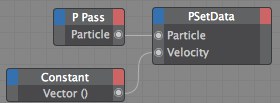Parameter
 We pass a group of particles to PSetData and control their velocities with a Constant node, of type vector (giving both direction and speed). See the PBorn example for a more complex setup.
We pass a group of particles to PSetData and control their velocities with a Constant node, of type vector (giving both direction and speed). See the PBorn example for a more complex setup.Sets the global position of the particles.
Defines the direction and speed of the particles. The length of the vector sets the speed and the direction sets the direction of the motion.
Sets the new life span of the particles, in seconds.
Sets the age of the particles.
The Size value is a scaling factor for the objects used as particles. The ratio of Size to Bounding Radius (see the PShape node for details on the Bounding Radius) gives the scaling factor: (Size/Bounding Radius)*size of the object=size of the particle object. So if you want the particle object to be exactly the same size as the original object, set Size to the same value as Bounding Radius. You can vary the size of each particle using the Size Variation parameter.
The axis of each particle is scaled by this value, enabling you to squash or stretch particles.
Defines the mass of the particles as a Real number (i.e. the value must be of the data type Real). The mass will affect how the particles react to dynamics forces such as wind. The greater the mass, the less the particles react to these forces.
This matrix sets the orientation of each particle, not the direction in which they move.
You can connect a PSpinConvert node to this port to control the rotation of the particles.
Here you can change which object is used as the shape the particles. Note that you cannot connect a PShape node directly to this port. Instead use, for example, a PGetData node to read a shape and pass this on to the PSetData node.
DT stands for Delta Time. This is a multiplier for the internal calculation of the particles’ time values. The default value is 1, which means that particle time is equivalent to animation time. Lower values will lead to a slower particle time, higher values to a faster particle time. You can use this for fast forward or slow motion particle effects.
Adds color to particles with which they will be displayed in the Viewport. See also Color
• Random Seed [-2147483648..2147483647]
The randomness of any variation is based on this value. The same random look will be generated each time you play back the animation unless you change this value.
A Boole value of True switches the node on; a value of False switches it off.
Connect this port to the particle stream, such as to the Particle output port of a PPass node, whose values should be set.
Here you can connect a TP Group data type, which you can access from a PGetData node, for example. This will allow you to assign the particles coming into the node to a new group (the group defined by the Group input port). You cannot connect a PPass node directly to this port.